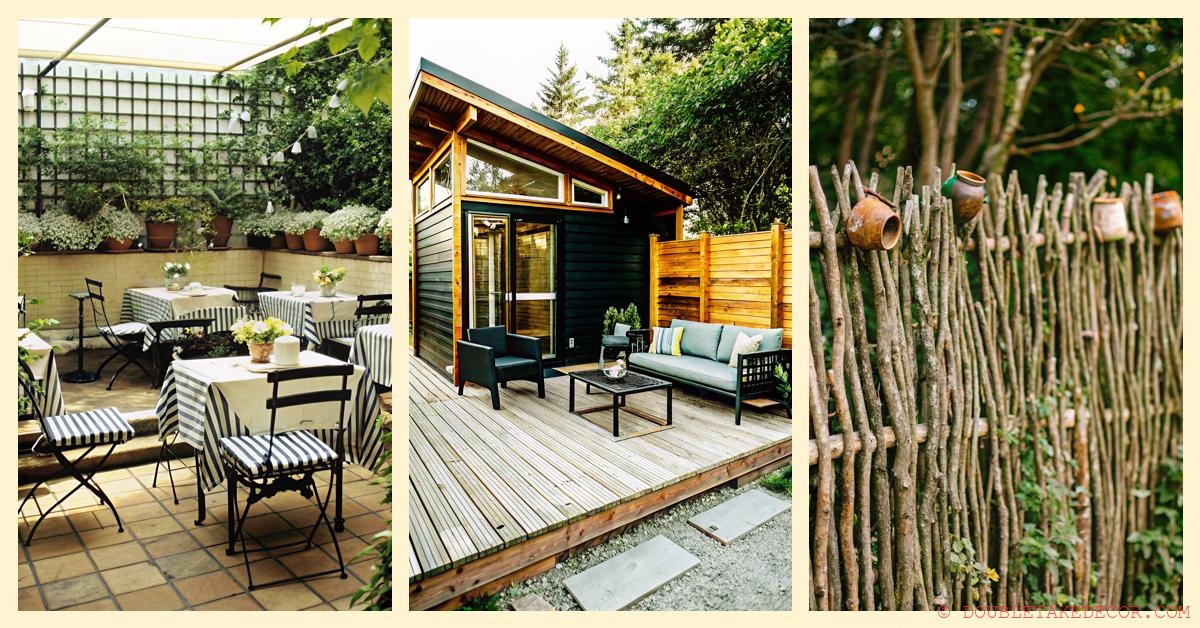
Creating the perfect backyard layout begins with careful evaluation of your space and understanding exactly what you want from your outdoor area. Whether you’re dreaming of a relaxation haven, entertainment zone, or flourishing garden, the design process requires balancing both aesthetics and functionality to achieve optimal results.
Essential elements like defined seating areas, thoughtfully placed pathways, and strategic planting can transform an ordinary yard into an exceptional outdoor living space. Modern tools such as 3D backyard planners offer invaluable visualization capabilities, allowing you to experiment with different arrangements before implementing any physical changes.
The article explores how organizing your backyard into distinct activity zones enhances both usability and visual appeal, while proper placement of utilities ensures long-term satisfaction. Creative solutions for incorporating built-in seating, retaining walls, and shade features address both practical needs and design considerations.
Even small gardens can become stunning outdoor retreats through vertical gardening, multi-functional furniture, and clever use of color and space. With thoughtful material selection and strategic planning, your backyard can evolve into a personalized oasis that perfectly balances beauty with functionality for years of enjoyment.
- 🏡 Personalized Outdoor Space: Designing the perfect backyard layout involves evaluating your space, understanding your needs, and balancing aesthetics with functionality to create a personalized outdoor oasis.
- 🛋️ Defined Zones for Usability: Organizing your backyard into distinct activity zones, such as seating areas, pathways, and gardens, enhances usability and visual appeal, catering to various interests.
- 🛠️ Visualization Tools: Modern tools like 3D backyard planners allow you to experiment with different layouts, ensuring your design aligns with your vision before any physical changes are made.
- 🌿 Creative Solutions for Small Spaces: Small gardens can be transformed into stunning retreats with vertical gardening, multi-functional furniture, and clever use of color and space, maximizing both beauty and functionality.
Create a Cozy Conversation Hub with a Curved Sectional & Fire Pit
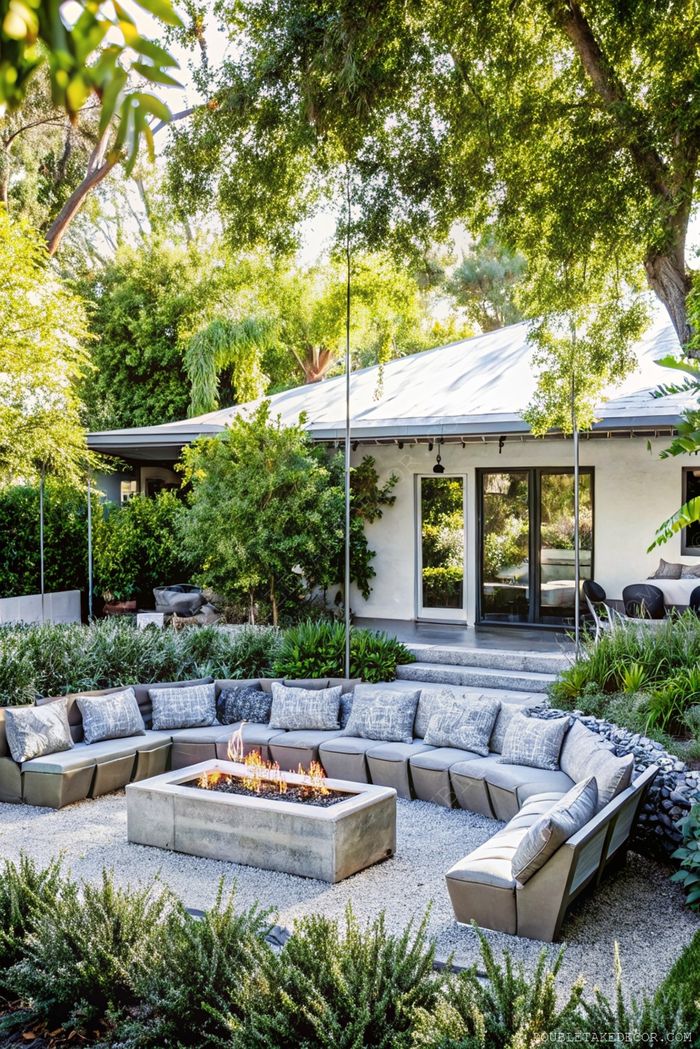
Transform your backyard into an inviting entertainment zone by pairing a curved sectional with a modern fire pit at its center. The arrangement naturally encourages conversation while maintaining sight lines across your space. Use neutral upholstery as your base and add personality with patterned cushions. Incorporate gravel flooring for drainage and minimal maintenance around your outdoor furniture investment.
Create Multi-Level Magic with Tiered Stone Retaining Walls
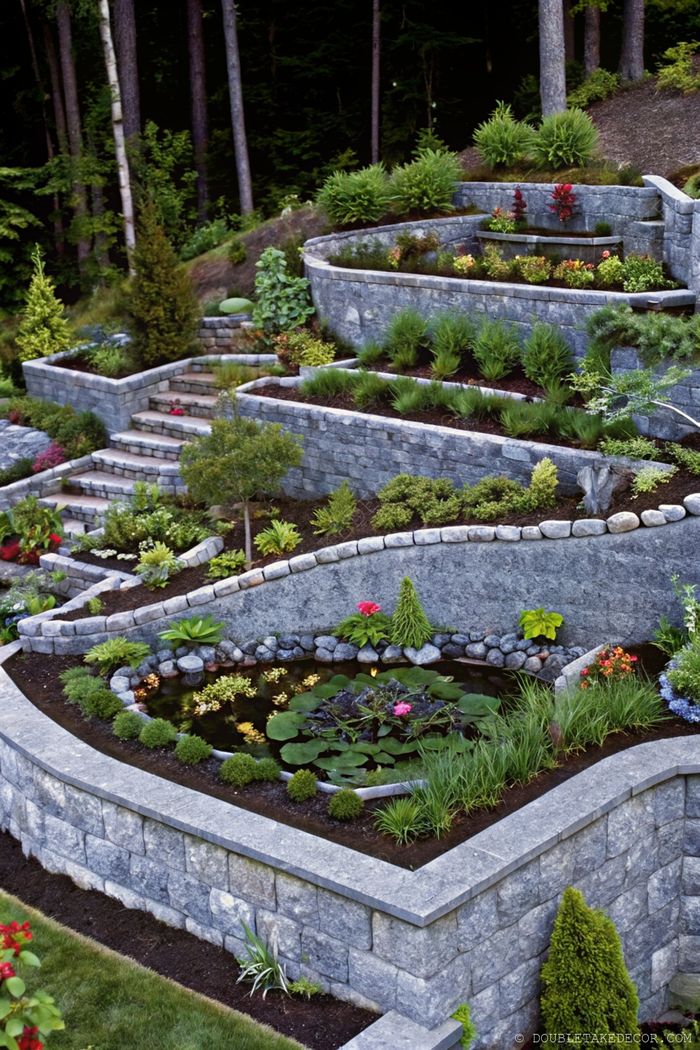
Transform sloped terrain into a stunning landscape feature by installing tiered stone retaining walls. Incorporate a cascading water feature between levels for soothing ambient sound. Plant different varieties at each tier for visual interest—shade-loving ferns below, sun-seeking flowers above. Pro tip: Use consistent materials for steps and walls to maintain design cohesion throughout your yard.
Create a Tranquil Pathway Garden with Mixed Textures
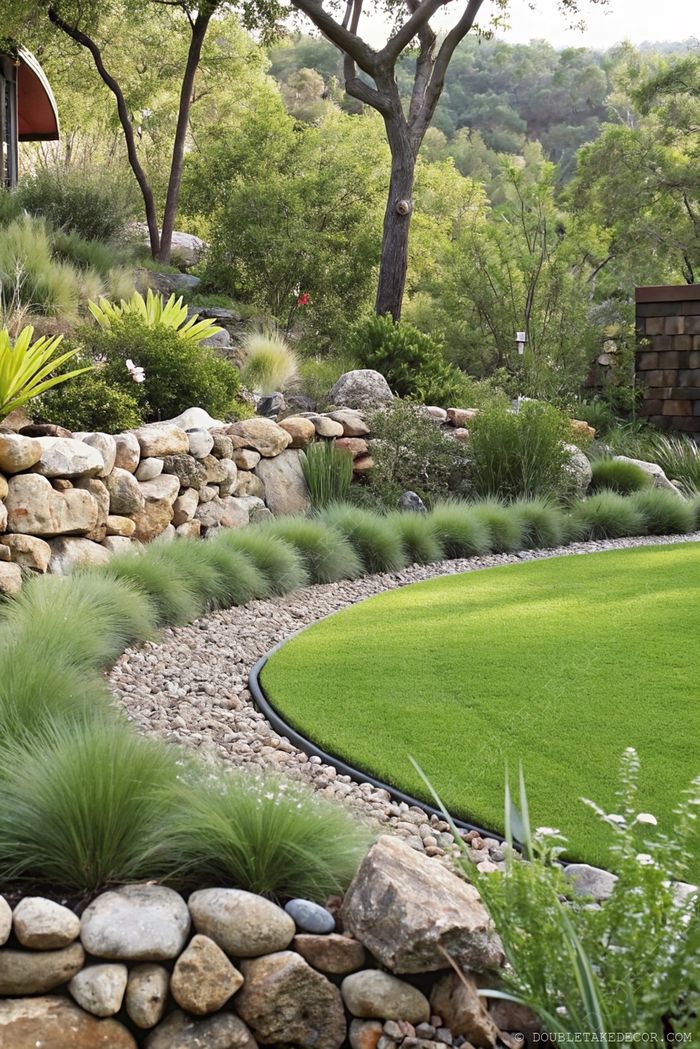
Design a winding stone pathway through your backyard to establish natural flow and visual interest. Combine artificial turf for low-maintenance greenery with ornamental grasses that provide movement and texture. Add structural elements like a rustic stone wall to create dimension while keeping the space functional. This balanced approach delivers year-round appeal without excessive upkeep.
Create a Romantic Garden Gazebo Retreat for Outdoor Dining

Transform your backyard with a classic white gazebo as a dedicated dining area. Position it amid lush greenery and enhance railings with vibrant floral arrangements. Add a simple dining set with crisp white tablecloth for elegant contrast against wooden decking. Place potted plants around the base to soften the structure and create a seamless transition to your garden landscape.
Elevate Your Courtyard with a Serene Circular Fountain Feature
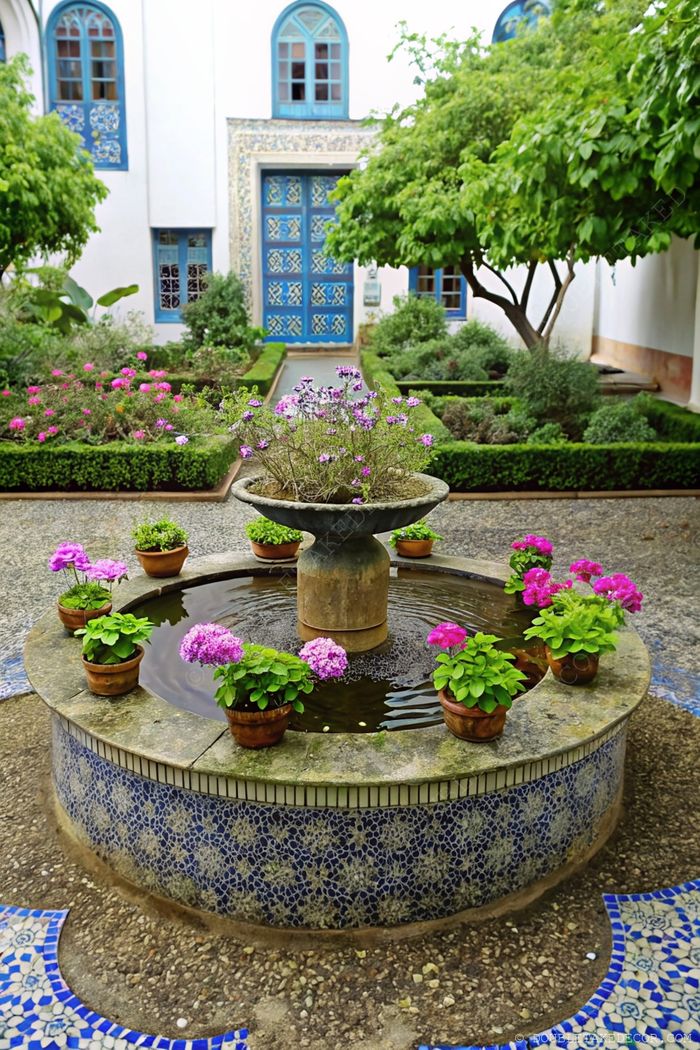
Create a tranquil focal point by positioning a stone fountain at the center of your courtyard. Surround it with colorful potted plants to enhance visual appeal and introduce seasonal variety. Complement with cobblestone pathways leading to the feature, and frame with neatly trimmed hedges for structure. This arrangement provides both aesthetic beauty and the calming sound of flowing water.
Create a Secluded Swing Sanctuary in Your Garden
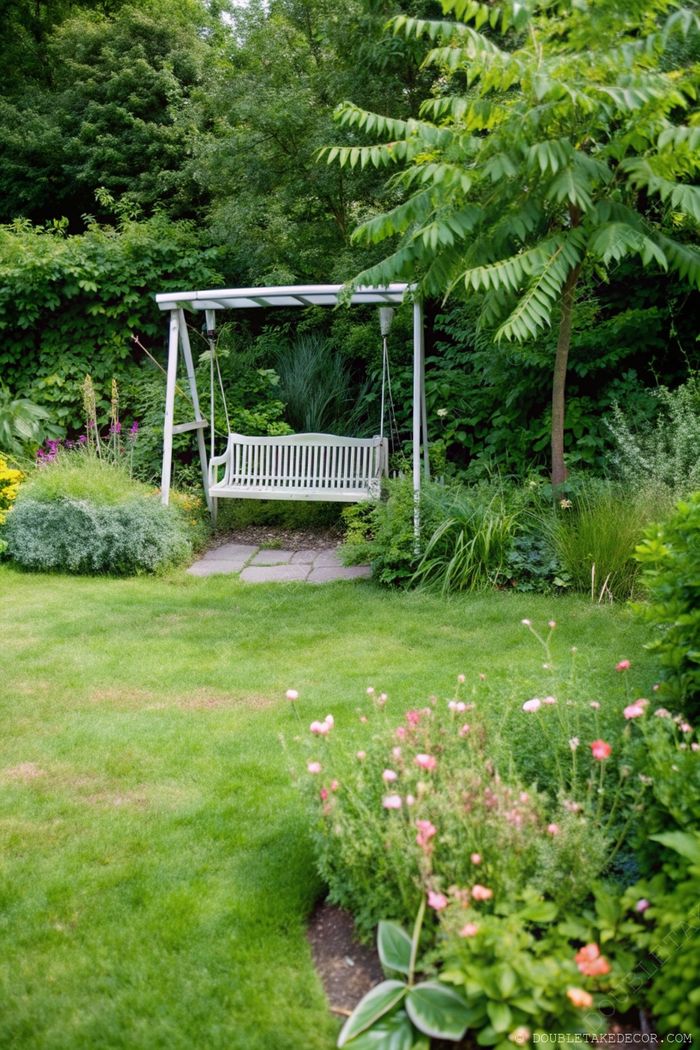
Transform a corner of your backyard into a tranquil retreat by installing a white swing bench under a simple canopy. Position it strategically among colorful flowers and lush greenery for maximum serenity. Add stone pathways leading to your sanctuary for both functionality and visual appeal. This design perfectly balances comfort with natural beauty, providing an ideal spot for peaceful contemplation.
Create a Meandering Path Through Your Garden for Enchanting Flow
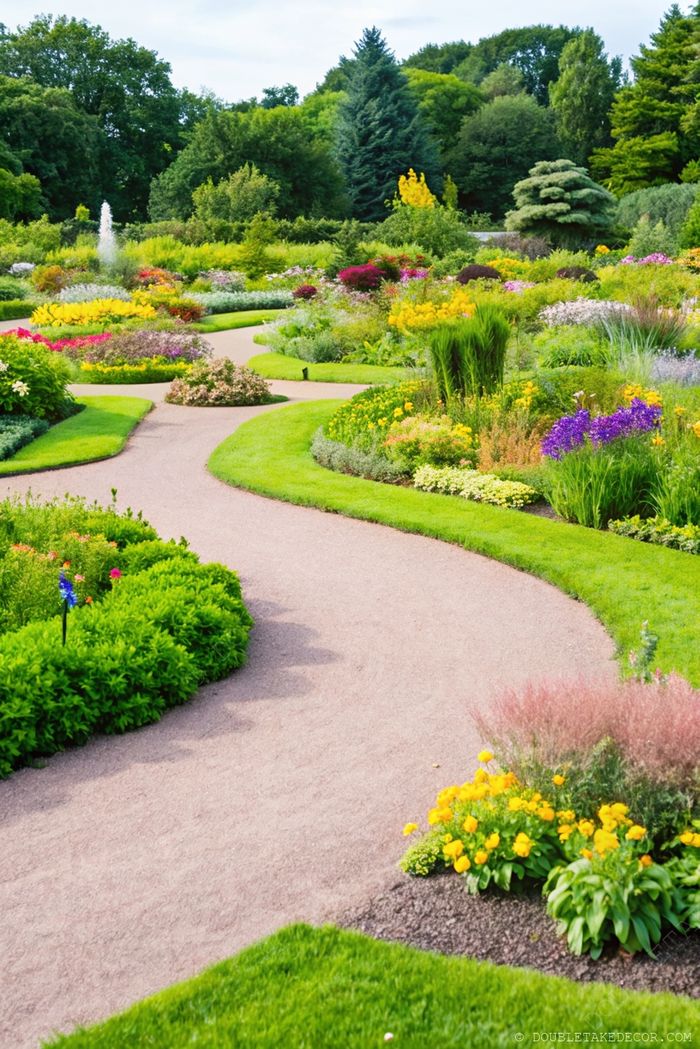
Design a curved gravel pathway that guides visitors through your garden’s most beautiful features. Border with varied height plantings—low flowers at edges and taller specimens behind. Incorporate focal points like a small fountain along the journey. This layout maximizes visual interest while creating distinct garden rooms to explore and enjoy.
Create a Serene Retreat with Butterfly Chairs on Pebble Bed
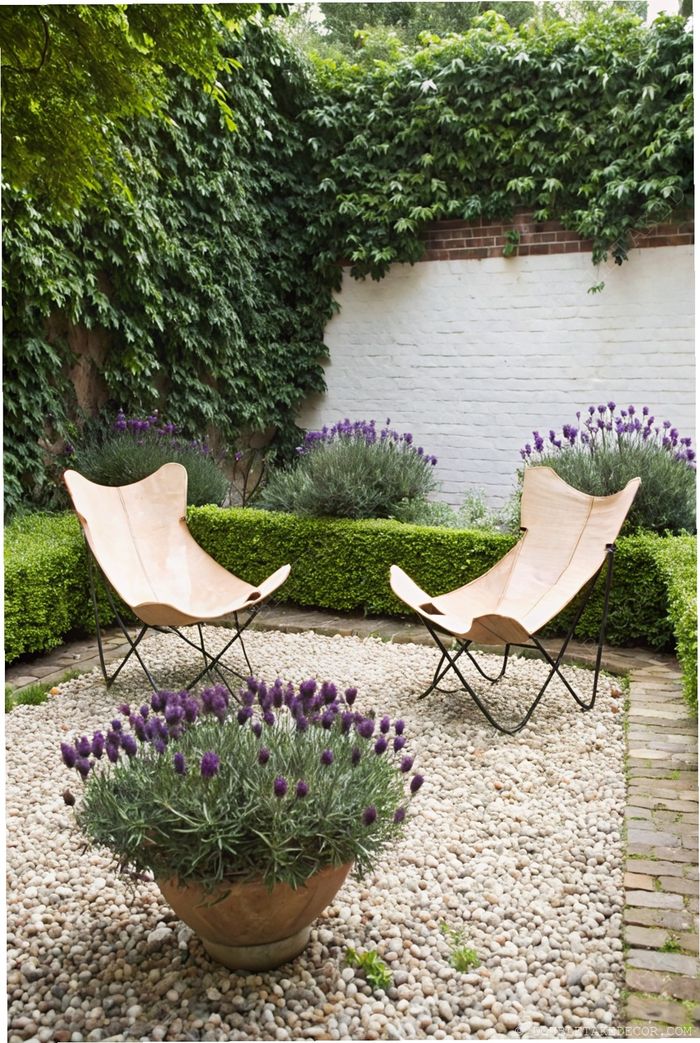
Design a minimalist relaxation zone by placing butterfly chairs on a smooth pebble base. Surround with fragrant lavender plants for sensory appeal and privacy. The combination of structured hedges and white brick walls creates a peaceful backdrop. This low-maintenance setup offers both style and functionality while requiring minimal upkeep throughout the seasons.
Create a Luxurious Backyard Retreat with a Modern Fireplace Pavilion
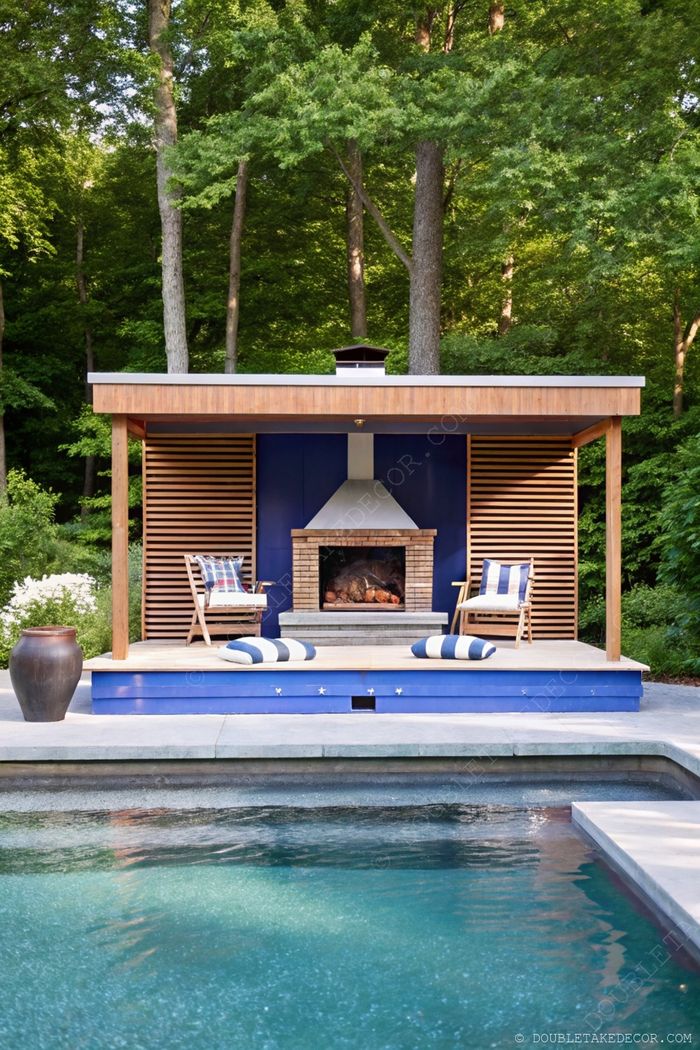
Design an elegant outdoor living space by installing a contemporary open-air pavilion with a stone fireplace as the focal point. Position comfortable seating with coordinated cushions around the fire feature for intimate gatherings. Place the structure near your pool to establish a cohesive entertainment zone that transitions seamlessly between relaxation areas. Add rich color accents that complement your landscape.
Create a Cabin-Inspired Garden Retreat with Rustic Appeal
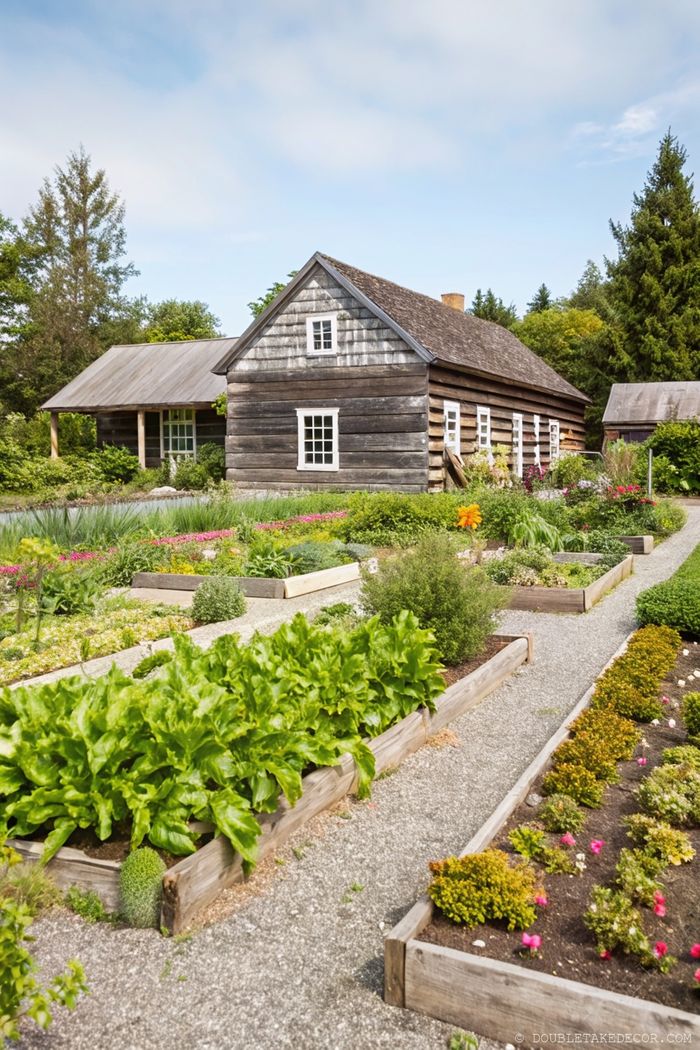
Transform your backyard into a rustic haven by combining weathered wood elements with structured garden beds. Arrange plants in organized sections separated by gravel pathways for easy maintenance and visual appeal. Balance vibrant flowers with leafy greens for year-round interest. Include a small wooden structure or shed as a focal point to complete this serene country-inspired landscape.
Design a Sophisticated Outdoor Dining Area with a Modern Pergola
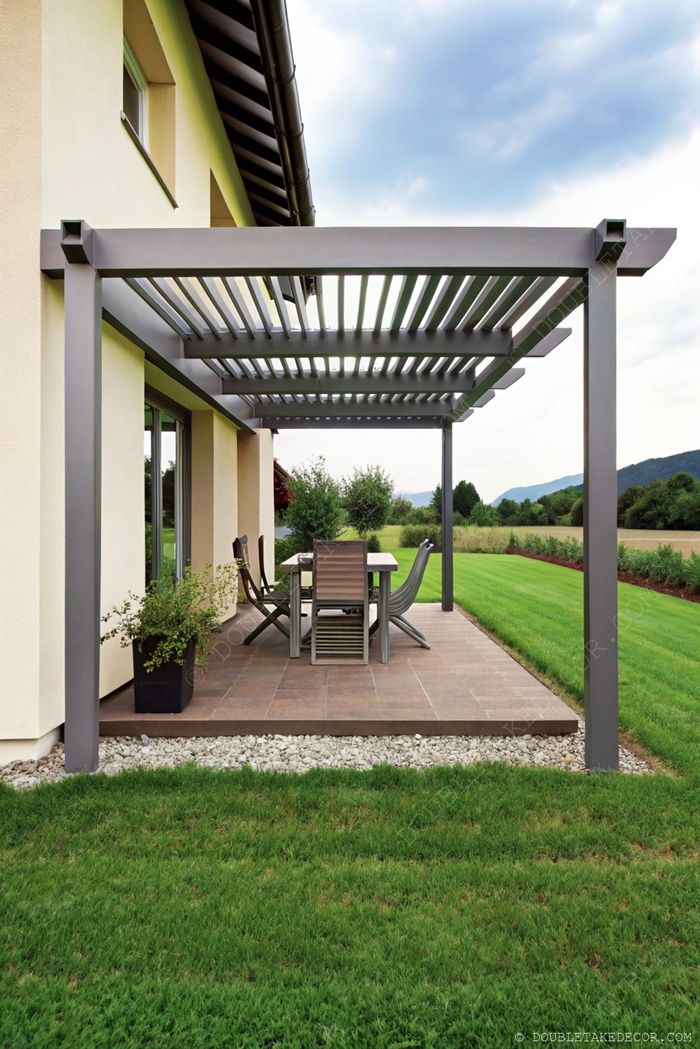
Create a high-end entertainment space by installing a contemporary pergola with horizontal slats that perfectly balance sun and shade. Position your dining set underneath to establish a defined outdoor room. Add potted plants for visual interest and choose durable tile flooring for practicality. This clean-lined design works particularly well against natural backdrops, providing structure without overwhelming the landscape.
Create a Tranquil Stone Pathway Leading to Your Garden Sanctuary
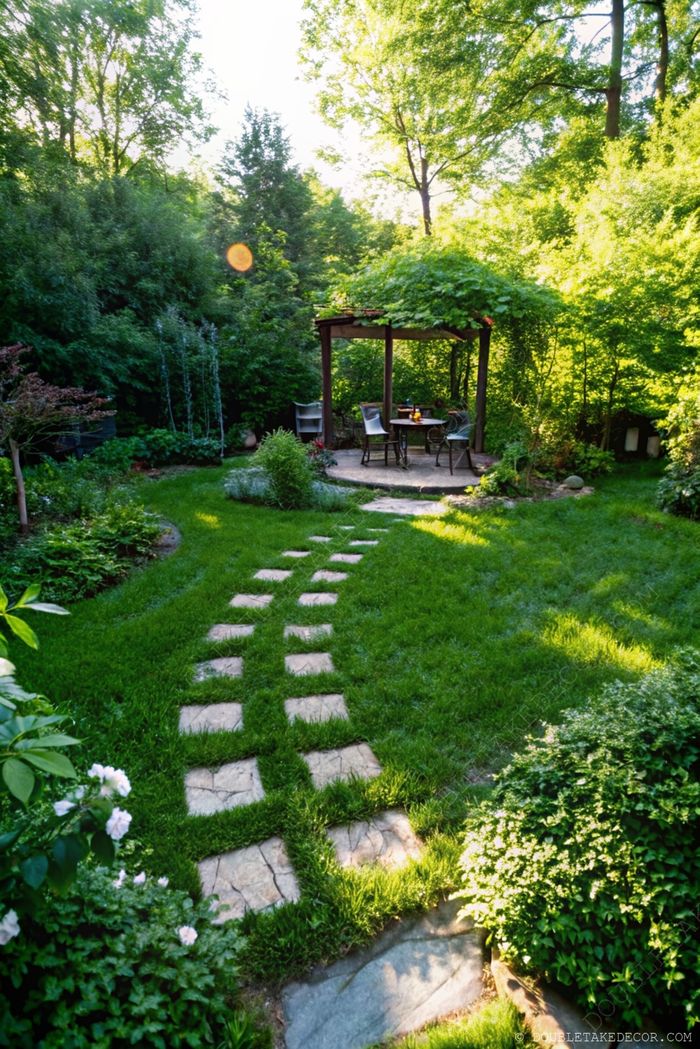
Design a winding path using square stepping stones through your lawn to connect spaces elegantly. Position stones with enough spacing for comfortable walking while maintaining a natural flow. Complement with a pergola-covered seating area for shade and privacy. Add climbing plants for vertical interest and extra cooling during summer gatherings.
Create Flowing Flower Beds with Colorful Tulip Arrays
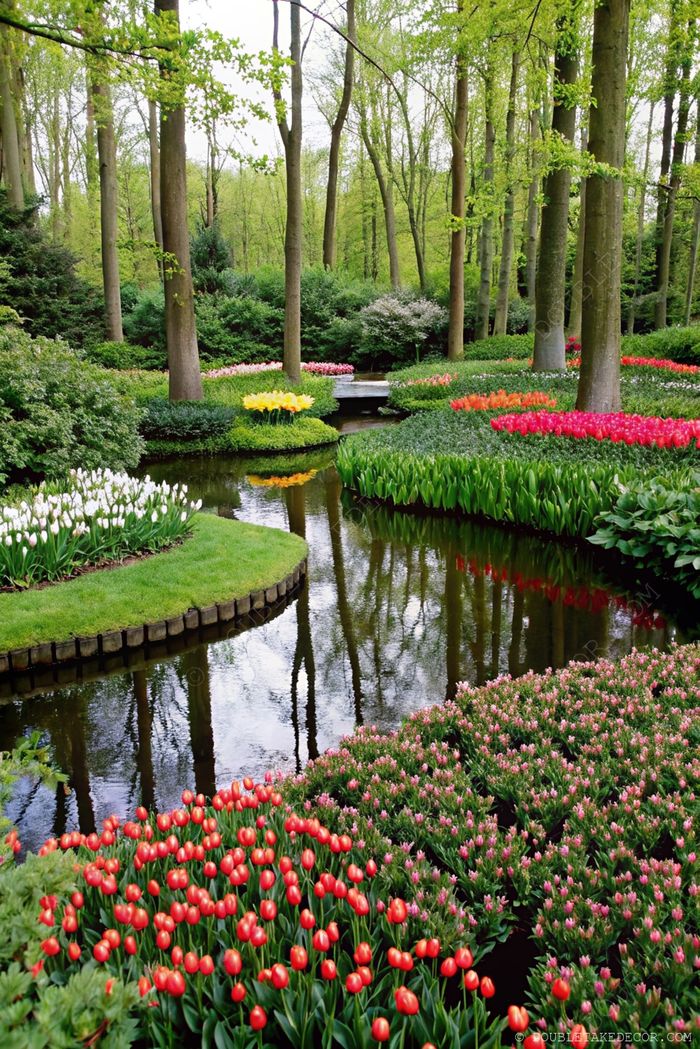
Design curved tulip beds to guide the eye through your backyard landscape. Plant varieties in complementary color blocks for maximum visual impact. Position near water features to enhance the reflection effect. This arrangement not only creates stunning seasonal interest but also establishes natural pathways that invite exploration through your garden space.
Create a Tranquil Pond Oasis with Strategic Plant Layering
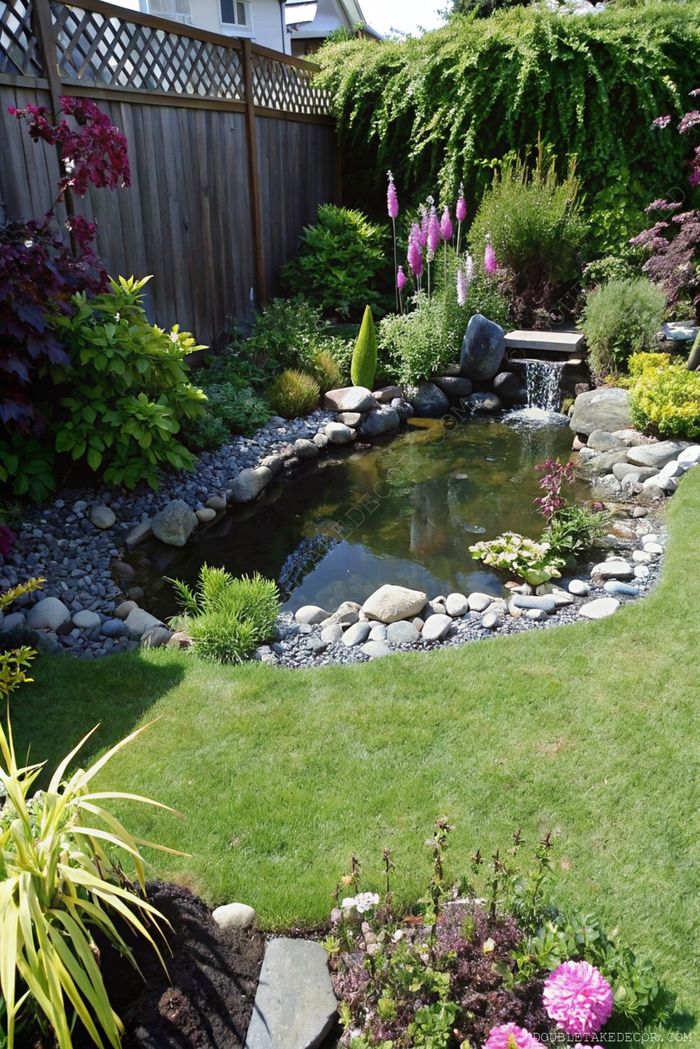
Design your backyard water feature with strategic stone placement around the perimeter for natural containment. Layer tall flowering plants behind the pond and shorter varieties in front for dimensional appeal. Include a small waterfall for soothing sounds and water circulation. Maintain a pristine lawn backdrop to enhance the pond’s visibility as a centerpiece element.
Create a Tranquil Retreat with a Suspended Macramé Chair
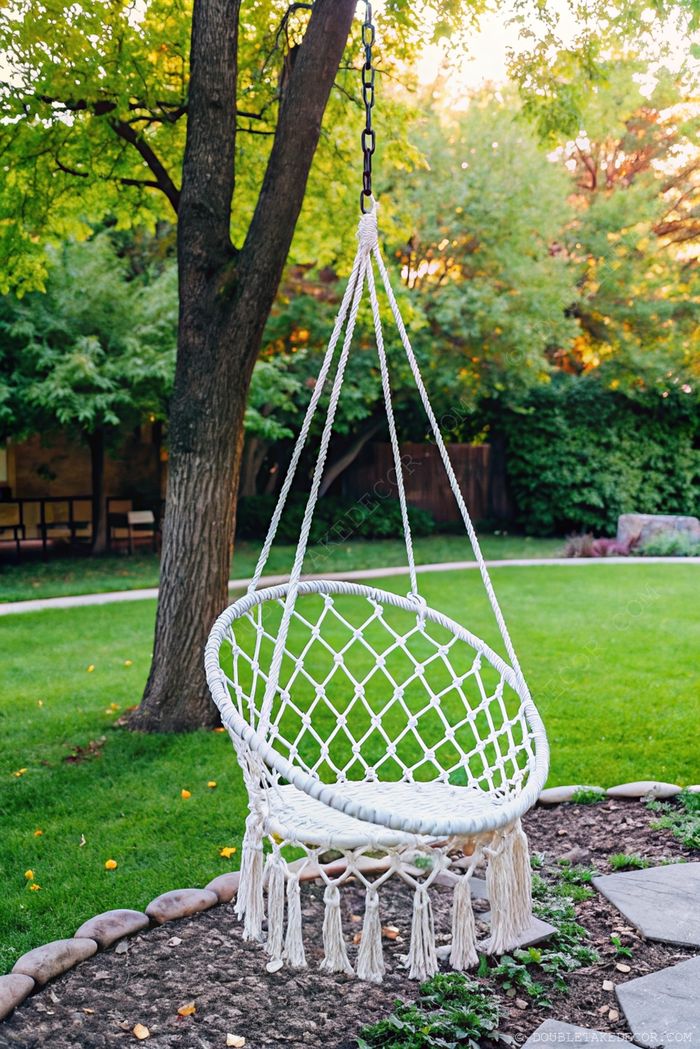
Transform any corner of your backyard into a peaceful sanctuary by hanging a macramé chair from a sturdy tree branch. Position it near a garden path to maximize views of your landscape. Add weather-resistant cushions for comfort during extended reading sessions. Ensure proper installation with heavy-duty hardware rated for your weight capacity.
Create a Multi-Level Backyard Retreat with Defined Spaces
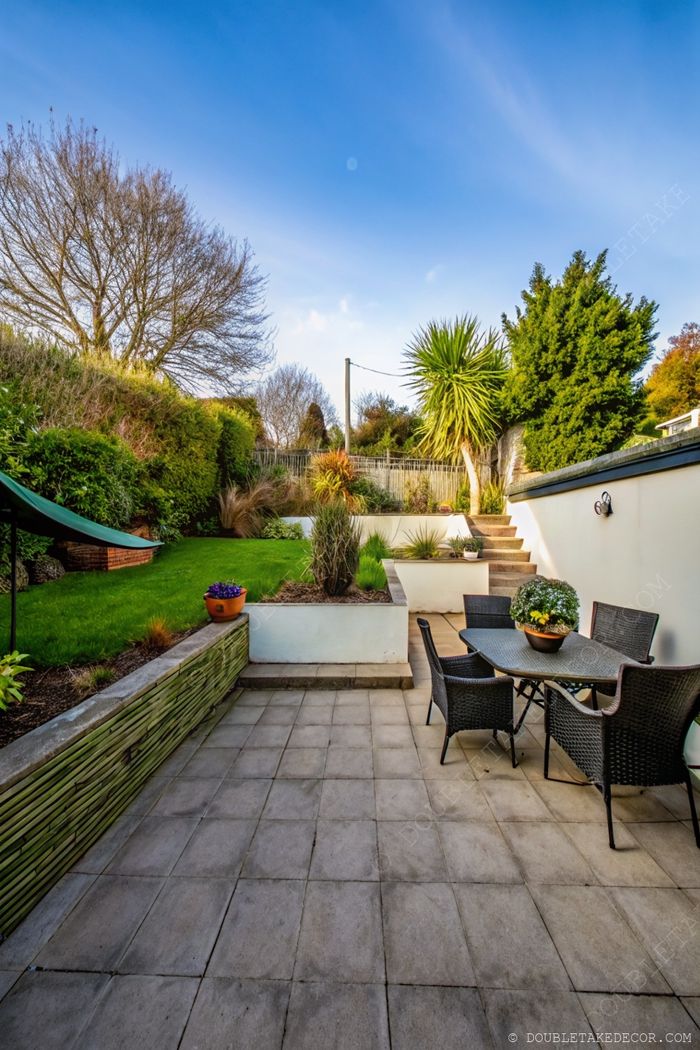
Design your backyard with distinct functional zones by using tiered landscaping. Position a comfortable dining area on a tiled patio closest to the house, then transition to a lush lawn surrounded by ornamental grasses. Add elevation with stepped garden beds for visual interest and privacy. This layout maximizes usability while maintaining a cohesive flow.
Design a Multi-Functional Backyard Oasis with Guest Cabana
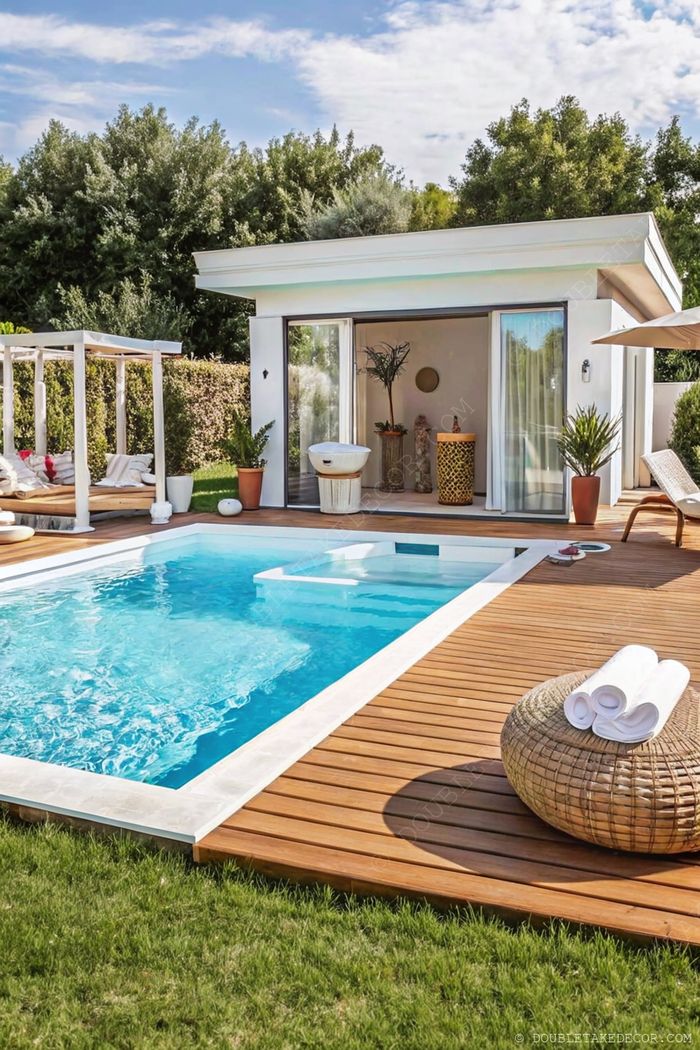
Maximize your outdoor space by integrating a sleek swimming pool with a contemporary guest cabana. Create distinct zones using wooden decking and pergolas for shade. Position seating areas strategically for conversation and poolside relaxation. Include practical elements like accessible towel storage and ensure seamless indoor-outdoor flow with large sliding doors. This design offers both luxury and functionality.
Create a Natural Stone Pathway to Elevate Your Backyard’s Appeal

Install large, flat stone steps to create a functional and elegant pathway through your landscape. Surround with mixed textures of grasses and leafy shrubs for a balanced look. Position taller trees strategically in the background for shade and visual depth. This design works particularly well on sloped areas, transforming challenging terrain into a garden highlight.
Create a Focal Point with a Decorative Birdbath
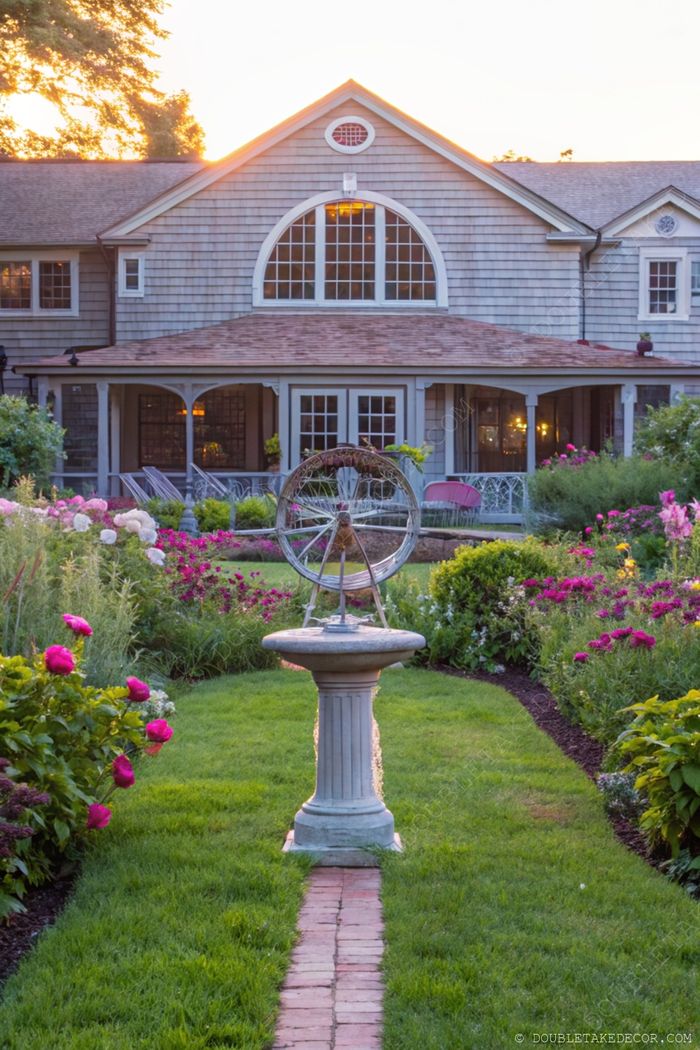
Establish visual interest in your backyard by installing a charming birdbath as a centerpiece. Position it along your brick pathway where it can be admired from multiple angles. Surround with vibrant flowers like peonies for a pop of color. This water feature not only enhances your landscape design but also attracts beautiful wildlife to your outdoor space.
Create Captivating Contrast with Hydrangea-Focused Pathways
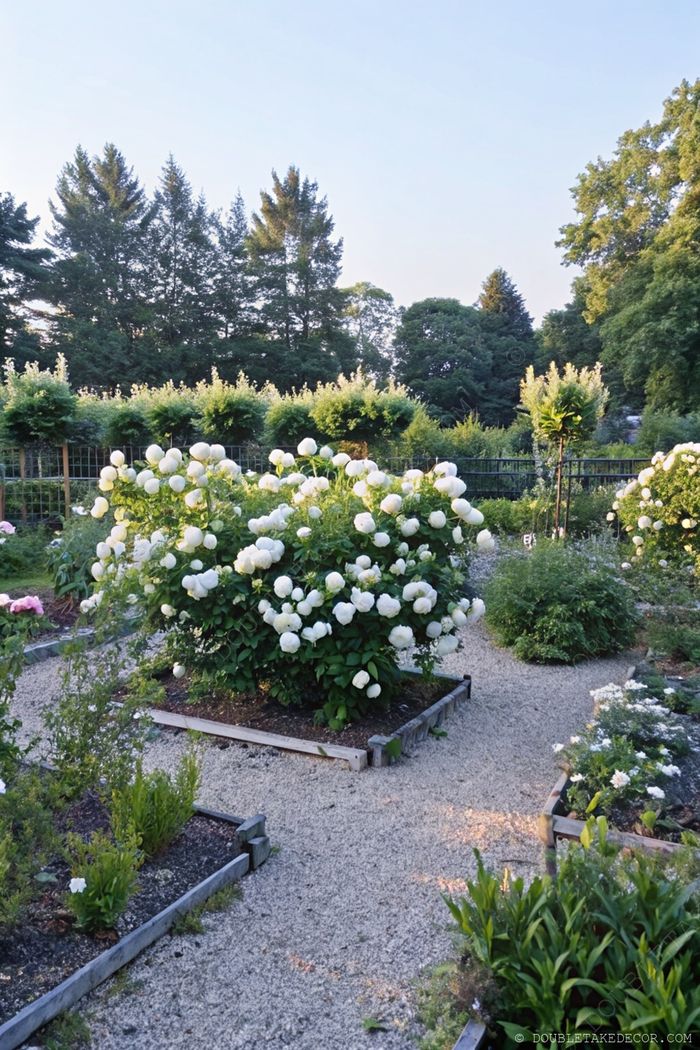
Design your backyard with striking white hydrangeas as focal points alongside meandering gravel pathways. Position these showstopping blooms against lush greenery and complement with pastel pink flowers for depth. Incorporate mature trees as natural backdrops to enhance the serene atmosphere. This layout creates both visual interest and tranquil spaces perfect for relaxation or quiet contemplation.
Create a Spa Retreat with Stone Patio and Natural Integration
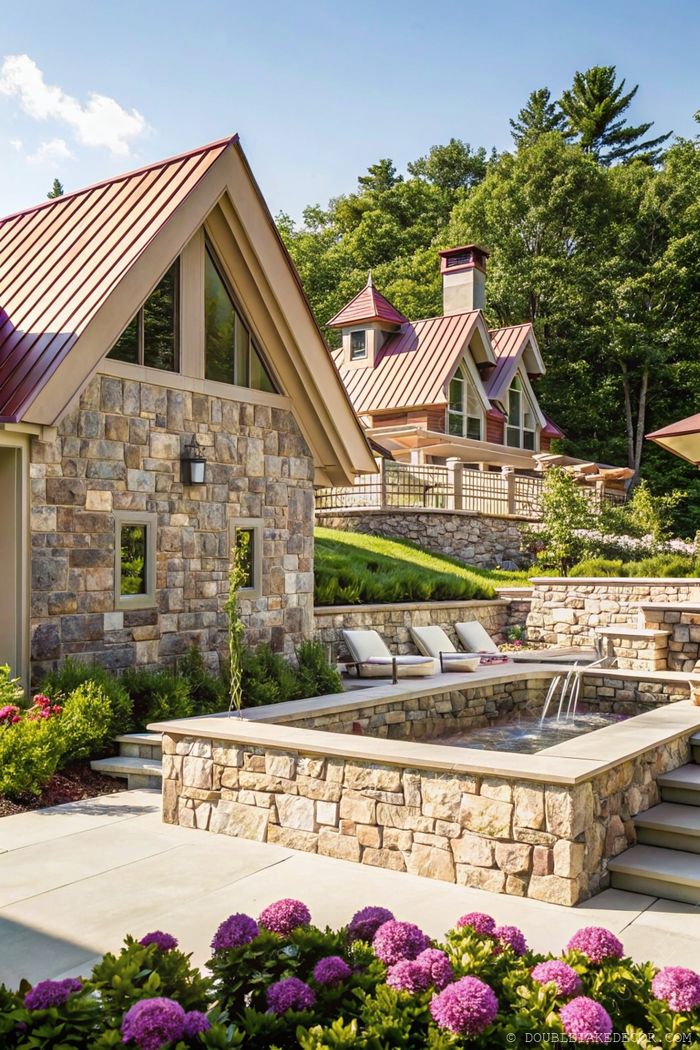
Transform your backyard into a luxurious escape by installing a hot tub surrounded by natural stone walls. Position comfortable lounge chairs nearby and incorporate vibrant flowering plants for added color. The combination of stone elements with wooden structures creates visual harmony. Pro-tip: Consider metal roofing that complements your landscape for a cohesive outdoor retreat experience.
Elevate Your Backyard with a Tiered Stone Wall Garden Display
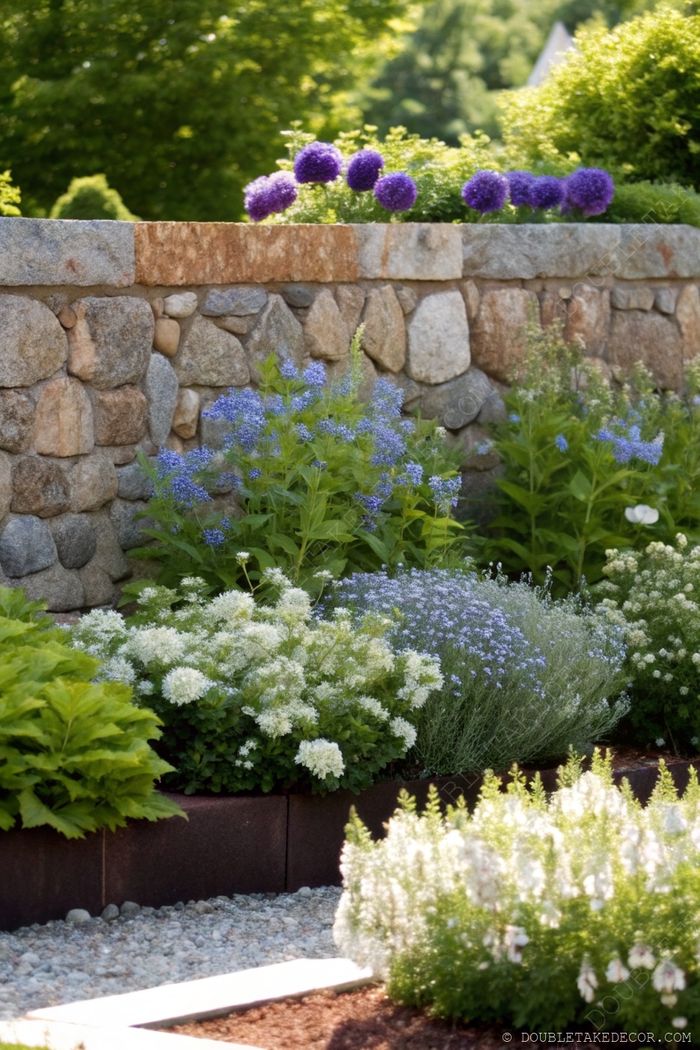
Create visual interest in your landscape by installing a natural stone retaining wall with built-in planting pockets. Layer low-growing ground covers in the foreground with mid-height perennials and cascading flowers along the wall. Pro tip: Choose contrasting flower colors like purple and white for dramatic impact against the stone texture.
Create a Stone Pathway Oasis Leading to Your Pool
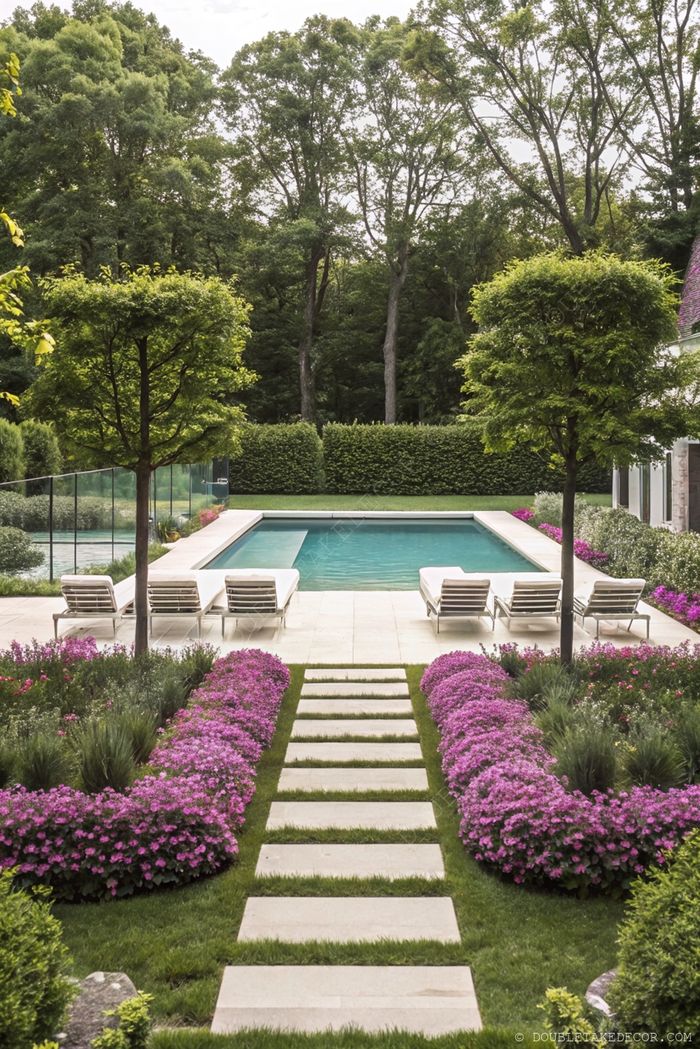
Install large, flat stepping stones through your lawn to connect garden areas with your pool. Position the pathway to showcase colorful flowerbeds as natural borders—pink blooms work beautifully against green grass. Enhance privacy with neatly trimmed hedges around the pool area while maintaining an open, symmetrical layout. This design balances accessibility with elegant landscaping for ultimate relaxation.
Create Peaceful Retreat Zones with Strategic Seating Placement
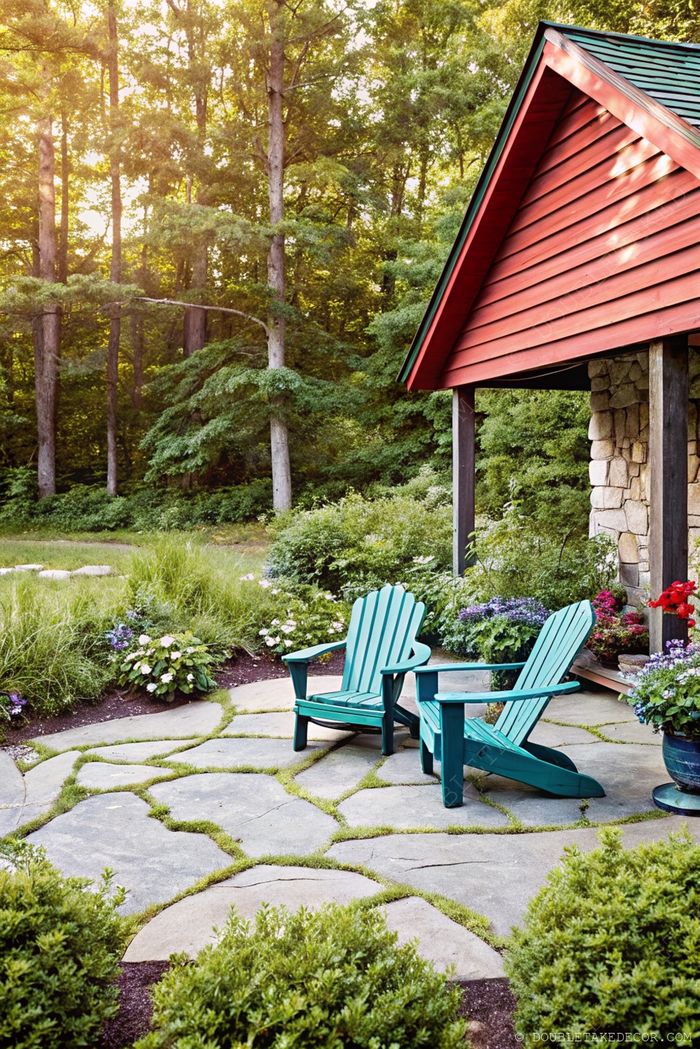
Position comfortable Adirondack chairs on stone patios with grass interspersions to establish dedicated relaxation areas. Surround seating with colorful flower beds for visual interest while maintaining sightlines to architectural features. This layout creates purpose-driven spaces within your backyard landscape, encouraging daily use and connection with nature.
Design a Symmetrical Poolside Oasis for Ultimate Relaxation

Create balance in your backyard by placing matching lounge chairs on either side of your rectangular pool. Enhance the space with a small accent table adorned with fresh flowers. Maintain manicured lawn areas for a clean aesthetic that highlights the water feature. Incorporate mature trees around the perimeter to provide natural privacy and cooling shade during summer months.
Create a Private Outdoor Oasis with Strategic Fencing
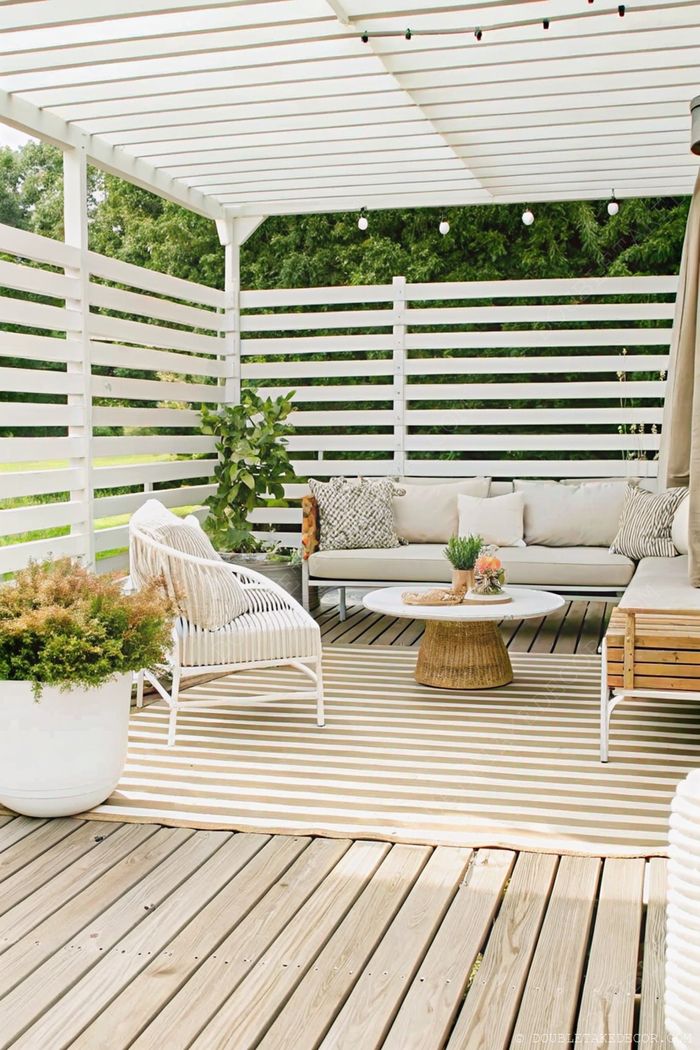
Install white slatted fencing to define your outdoor living area while maintaining airflow and light. Arrange comfortable seating with weather-resistant cushions and add texture with a neutral outdoor rug. Incorporate potted plants for natural touches. This layout maximizes privacy without feeling enclosed, perfect for entertaining or peaceful retreats.
Create a Tranquil Conversation Area with Layered Outdoor Elements

Transform your backyard into a welcoming retreat by arranging wooden chairs around a coffee table on a patterned outdoor rug. Hang string lights overhead for evening ambiance and incorporate potted plants for natural accents. Use a fence as a backdrop to define the space while providing privacy. This layout works perfectly for both intimate gatherings and everyday relaxation.
Create a Welcoming Front Path with Large Rectangular Pavers
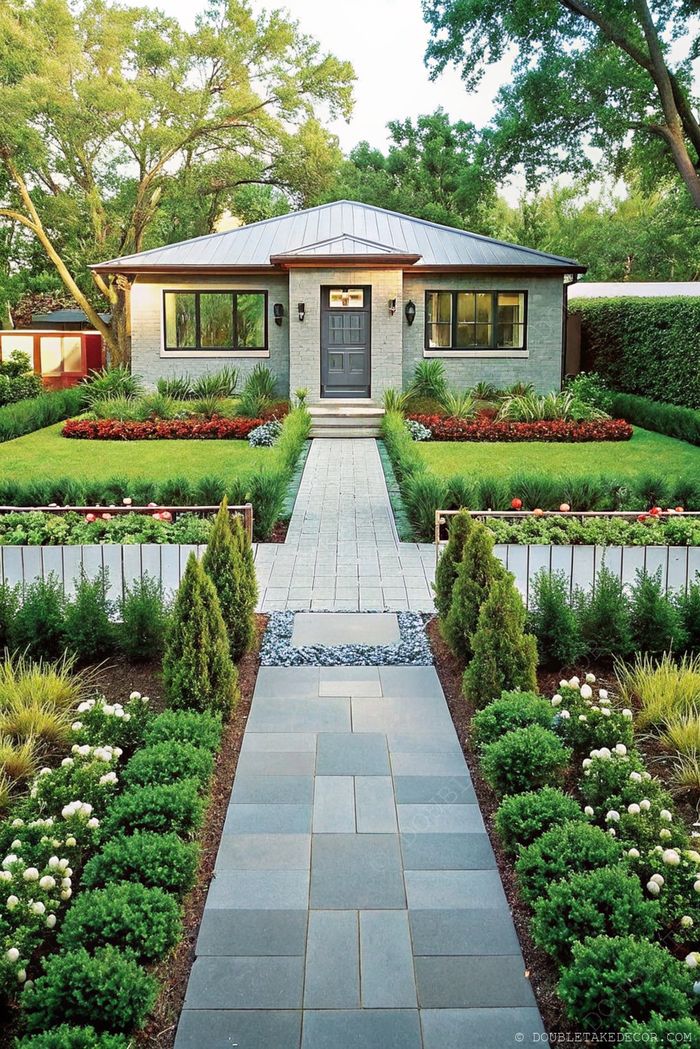
Design a striking entrance to your backyard by installing oversized rectangular pavers for your main walkway. Flank the path with manicured lawn edges and vibrant seasonal flower beds to enhance curb appeal. Incorporate compact evergreens for year-round structure and ornamental grasses for texture. This approach creates a clean, contemporary aesthetic while maintaining a natural flow to your outdoor space.
FAQ
What Is the Design Process for a Functional Backyard Layout?
To create a functional backyard, begin by evaluating the available space. Measure it and take note of any trees, slopes, or existing structures. This insight is crucial for designing an area that is both attractive and practical.
Consider what you want from your backyard. Are you looking for areas to relax, entertain guests, or perhaps garden? Understanding these preferences ensures that your backyard will effectively serve its purpose.
Sketching a rough draft can aid in visualizing potential layouts. Try out different arrangements that align with your desires while also factoring in practical considerations like sunlight exposure and drainage.
When selecting plants, materials, and structures, conducting thorough research is vital. Opt for native plants that require minimal maintenance and choose materials resilient to local weather conditions.
As a final step, enhance your design by incorporating functional features such as walkways for easy navigation or retaining walls to manage slopes. Strive to achieve a harmonious blend of aesthetics and utility in your backyard design.
What Elements Are Essential in a Backyard Layout?
When designing a backyard, it’s essential to define areas for seating, pathways, and gardens.
- incorporating patios or decks can enhance the usability of the space,
- selecting suitable plants like trees and shrubs is crucial for aesthetics and functionality,
- water features and lighting add charm and practicality,
- including a built-in grill provides convenient outdoor cooking options.
- together, these elements create a harmonious design that blends functionality with visual allure.
How Do You Use a Backyard Planner for Layout Creation?
A backyard planner is an invaluable tool for designing your outdoor area. It allows you to input dimensions and experiment with different design elements effortlessly. Many planners offer a drag-and-drop feature for items such as:
- plants,
- furniture,
- structures.
This enables you to visualize your ideas in either 2D or 3D. This visualization helps you grasp how everything will fit together, ensuring that your spacing decisions are well-informed before you make any actual changes. By using a backyard planner, you can create a design that is not only functional but also aesthetically pleasing, perfectly aligning with your style and requirements.
What Role Does 3D Backyard Design Play in Visualization?
Using 3D design for backyard projects significantly enhances our ability to envision outdoor spaces. These tools provide a lifelike perspective of how plants, hardscaping, and various features will integrate in your yard. Homeowners can experiment with different arrangements and adjust them before any construction begins, ensuring the final result aligns with expectations and fulfills all functional requirements. Essentially, 3D design tools are invaluable for planning, allowing you to visualize how your entire outdoor area will come together.
How Should You Approach Materials Selection for Your Backyard?
Selecting materials for your backyard requires thoughtful planning to balance both functionality and style. Begin by evaluating the durability of materials, as they need to endure the local weather.
For hardscaping, consider options such as:
- pavers,
- stones,
- concrete.
Each offers distinct styles and maintenance requirements. Concrete is known for its toughness and low maintenance needs, while stones provide a natural appearance but may demand more cleaning.
When it comes to choosing plants, prioritize native species that thrive in your area. These plants typically require less upkeep and are better suited to the climate, enhancing garden sustainability while reducing water consumption.
Cost is another vital consideration in material selection. Striking a balance between quality and budget ensures long-term satisfaction without the hassle of frequent repairs or replacements.
Lastly, ensure that your material choices align with the overall design theme of your backyard. A consistent style results in a harmonious outdoor space that complements both your home’s architecture and landscape vision.
How Do Landscaping Ideas Enhance a Backyard Layout?
Landscaping ideas have the power to transform a backyard, making it both more appealing and functional. The right selection of plants introduces vibrant colors, varied textures, and seasonal interest to the space. Incorporating paths and patios enhances usability, while elements like raised beds, trellises, or water features can create striking focal points that elevate the overall atmosphere.
Organizing a backyard into distinct zones through landscaping brings order and warmth to the area. For instance, integrating seating areas or gardens assigns specific roles to each section, promoting social gatherings and maximizing the use of space.
Furthermore, choosing appropriate plants and materials is crucial for managing sunlight exposure and drainage effectively. This careful planning not only ensures a cohesive look but also guarantees durability and ease of maintenance.
Ultimately, creative landscaping can turn an ordinary backyard into an inviting outdoor haven that satisfies both aesthetic desires and practical needs.
What Are the Benefits of Creating Activity Zones in Your Backyard?
Designating specific areas in your backyard brings numerous advantages. By reserving spaces for dining, lounging, or gardening, you can organize more efficiently and maximize the utility of your outdoor environment. This strategy enhances the functionality of your yard, making it a dynamic and enjoyable place. These activity zones cater to various interests and encourage social interactions, infusing life into the space.
Furthermore, clearly defined zones facilitate smooth movement throughout the backyard. Each section fulfills its role without interfering with others, ensuring a seamless experience for everyone involved. Structuring your backyard into these functional sections also simplifies maintenance by demarcating areas that require different levels of care.
Ultimately, incorporating activity zones not only optimizes your use of the backyard but also boosts its aesthetic appeal by creating distinctive sections that address diverse needs and preferences.
How Do You Incorporate Built-in Seating and Outdoor Rooms?
Enhancing a backyard with built-in seating and outdoor rooms can significantly boost both comfort and functionality. Whether incorporated into walls or arranged around fire pits, built-in seating provides durable, space-efficient spots perfect for relaxation. Choosing materials like stone or wood that complement the overall design helps maintain a cohesive look.
Outdoor rooms can be defined using:
- pergolas,
- gazebos,
- strategically placed plants.
These elements not only provide shelter but also help organize the yard into unique zones. It’s crucial to consider how people will transition between these areas to ensure the design flows smoothly.
Seamlessly integrating these features with pathways and gardens requires careful planning of their size and layout. This thoughtful approach results in an inviting outdoor space that accommodates various activities while enhancing usability and visual appeal.
What Are the Best Practices for Utilities Placement in a Backyard?
Properly arranging utilities in your backyard is essential for their efficiency and to prevent future problems. Begin by considering drainage, water lines, and electrical access as part of the overall design. It’s important that these utilities don’t disrupt seating areas or gardens.
- water lines should be easily accessible for irrigation purposes,
- electrical outlets should be conveniently located near entertainment zones for easy access,
- effective drainage should utilize natural slopes to channel water away from structures, thus avoiding pooling or flooding issues.
Consulting with professionals can provide valuable insights on the best placements and ensure adherence to local regulations. With careful planning, you can create a backyard that is both functional and visually pleasing, fulfilling all necessary requirements without compromising on design.
How Do Retaining Walls and Walkways Fit into a Backyard Layout?
Retaining walls and walkways play a crucial role in shaping and enhancing the layout of a backyard. By managing slopes, retaining walls create flat surfaces perfect for planting or seating areas, while also providing essential structure to prevent soil erosion.
Walkways guide movement seamlessly through the backyard. They delineate spaces such as gardens, seating areas, or activity zones, simplifying navigation. This thoughtful integration not only improves accessibility but also elevates the visual charm of the space.
When it comes to selecting materials for retaining walls, choices like concrete blocks or natural stone offer distinct aesthetics and durability levels. It’s wise to coordinate walkway materials with these selections; pavers or gravel paths are favored for their versatility and straightforward installation.
Strategically placing retaining walls and walkways enhances both functionality and appearance, transforming any backyard into an organized outdoor oasis that caters effectively to various needs.
What Are Effective Ways to Add Shade to Your Backyard?
Enhancing your backyard with shade makes it a more inviting and functional space. You can plant trees like oak or maple, known for their broad canopies that offer natural shade. Alternatively, consider installing pergolas or awnings, which provide permanent cover for patios or seating areas. Shade sails add both visual interest and practical coverage, as they can be adjusted to different angles.
- outdoor umbrellas provide temporary shade,
- umbrellas can be easily repositioned as the sun moves throughout the day,
- trellises adorned with climbing plants such as ivy or wisteria introduce greenery while allowing dappled sunlight to filter through.
Each option comes with distinct advantages; select based on your aesthetic tastes and the specific areas in your backyard that require shading the most.
How Can a Garden Layout Plan Improve Your Outdoor Space?
Designing a garden layout can transform your outdoor area by providing an organized structure for plants and features. By considering the sunlight and water needs of each element, you create ideal conditions for growth, maximizing the space’s potential. This thoughtful arrangement allows you to carve out distinct zones for relaxation, entertainment, or gardening.
A well-designed plan not only enhances the visual appeal with strategic focal points but also simplifies maintenance tasks. It enables you to anticipate seasonal changes, allowing adjustments to be made as required. This meticulous planning ensures your garden remains both beautiful and functional throughout the year.
Incorporating landscaping ideas further elevates your garden layout. Selecting plants thoughtfully brings vibrant colors and textures, while adding hardscaping features like pathways boosts both practicality and aesthetics. With these considerations in mind, a garden layout plan transforms an ordinary backyard into a personalized oasis that is inviting and well-organized.
What Are Some Creative Solutions for Small Garden Layouts?
Creative approaches to small garden layouts can transform limited spaces into functional and beautiful areas.
- vertical gardening utilizes wall space for planting and maximizes the available area,
- container gardening adds flexibility, allowing you to rearrange plants easily to suit changing needs or aesthetic preferences,
- strategically placed mirrors can enhance the perception of space, making the garden feel larger.
Multi-functional furniture plays a vital role in optimizing usability by serving dual purposes; for instance, seating that doubles as storage is particularly useful. Organizing the garden with pathways and defined zones not only makes navigation simpler but also ensures each section fulfills its intended function effectively.
Opting for smaller plants prevents them from dominating the space, while thoughtful use of color introduces visual interest without creating clutter. By employing these creative strategies, a small garden can remain both practical and visually appealing, turning challenges into opportunities for innovative design solutions.
Guía Definitiva para Diseñar el Jardín Trasero Perfecto
Guide Ultime pour Concevoir l’Aménagement Parfait de ton Jardin
Ultimativer Leitfaden zur Gestaltung deiner perfekten Gartenlayout
Teljes útmutató az ideális kerti elrendezés megtervezéséhez
Komplexný sprievodca vytvorením perfektného rozloženia vašej záhrady
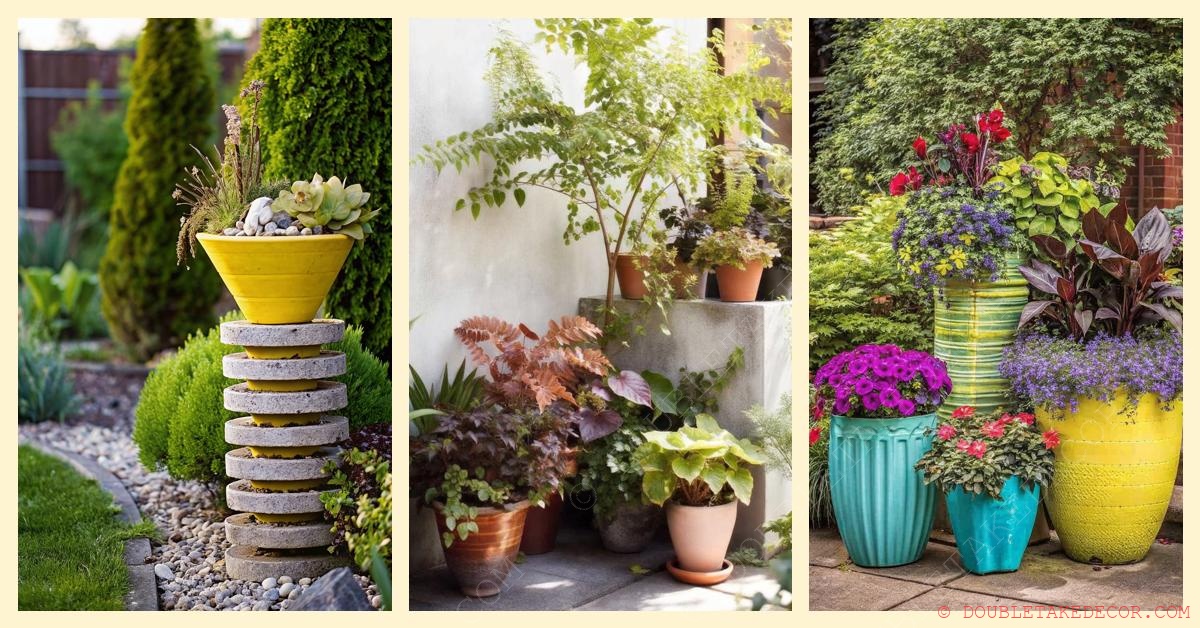
Creative Potted Plant Arrangement Ideas to Brighten Your Space
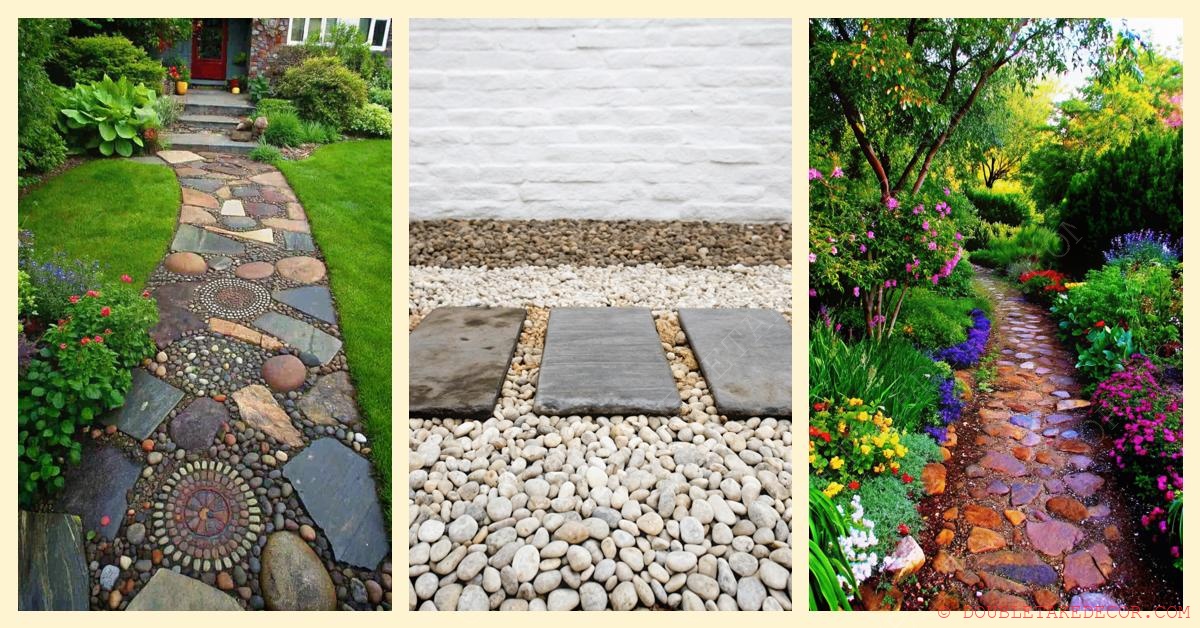
Enhance Your Garden Path with Beautiful Stepping Stones

Transform Your Backyard with a Cozy Garden Nook
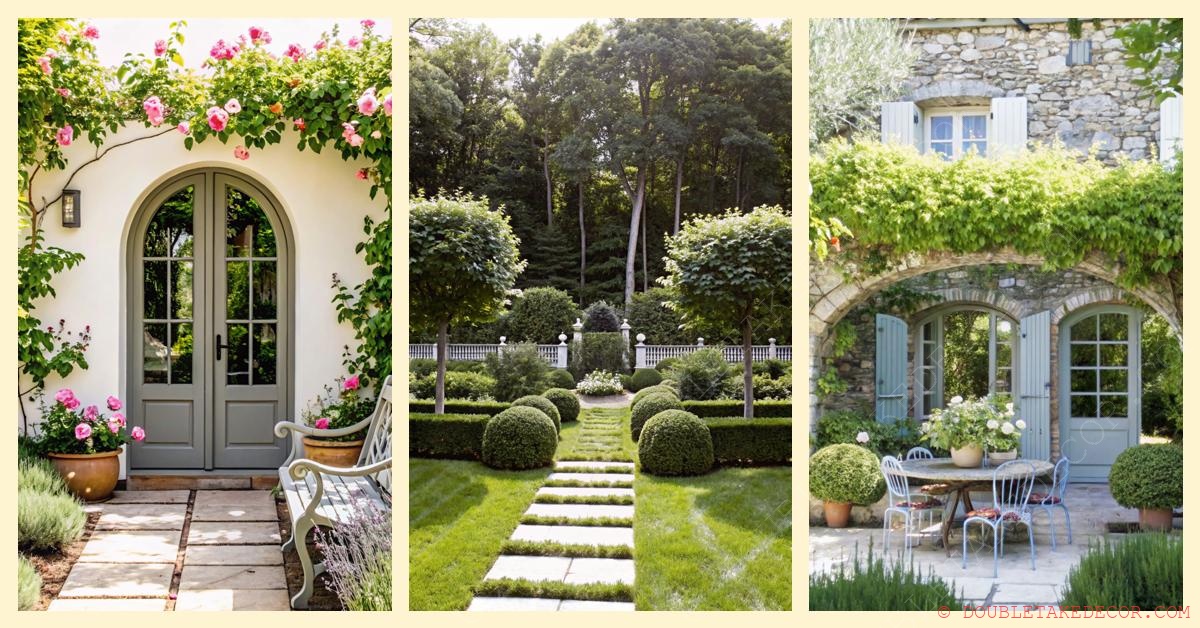
Creating Your Own French Garden: Design and Inspiration

Transform Your Curb Appeal: Inspiring Front of Home Landscaping Ideas
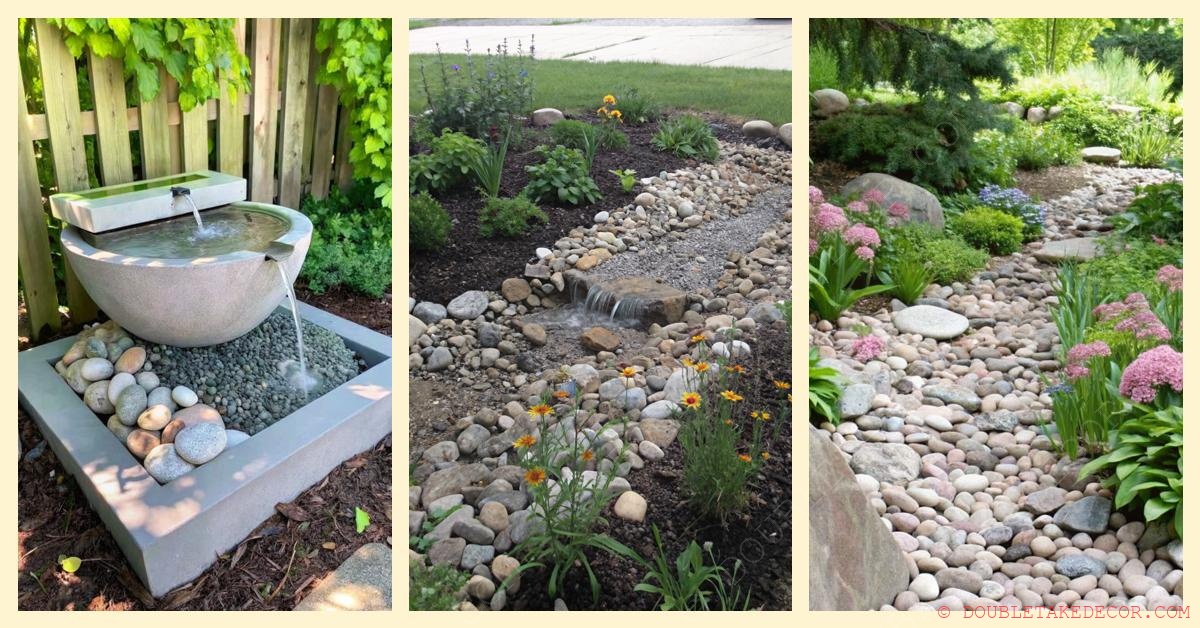
Innovative Rainscaping Ideas for a Sustainable Garden
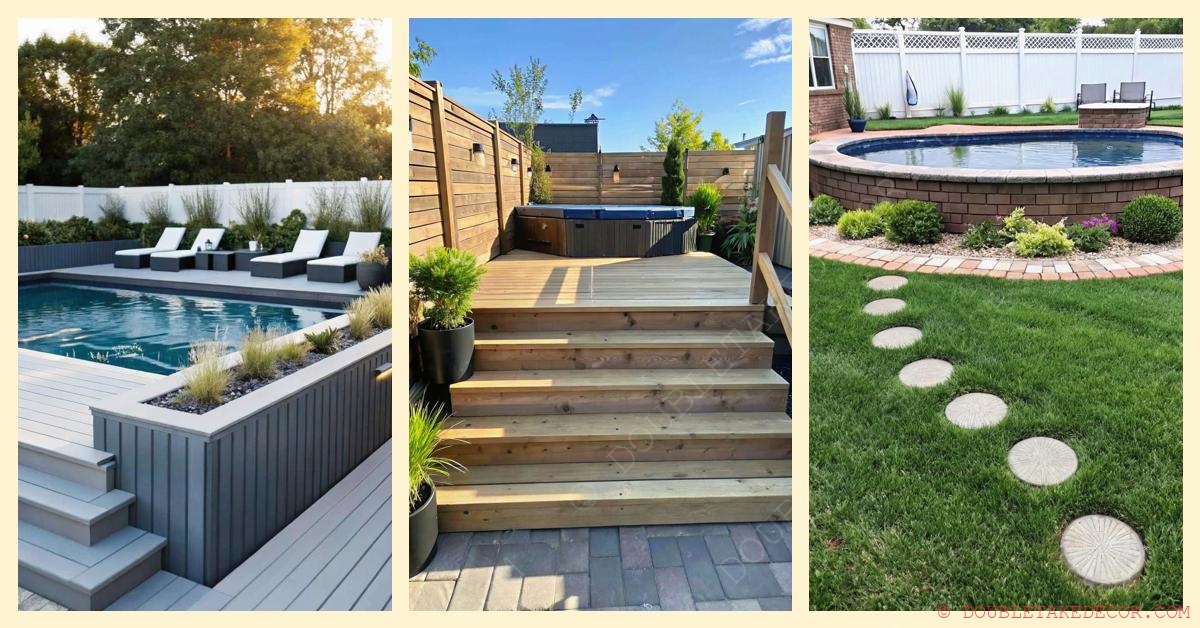
Stunning Above Ground Pool Ideas to Transform Your Backyard
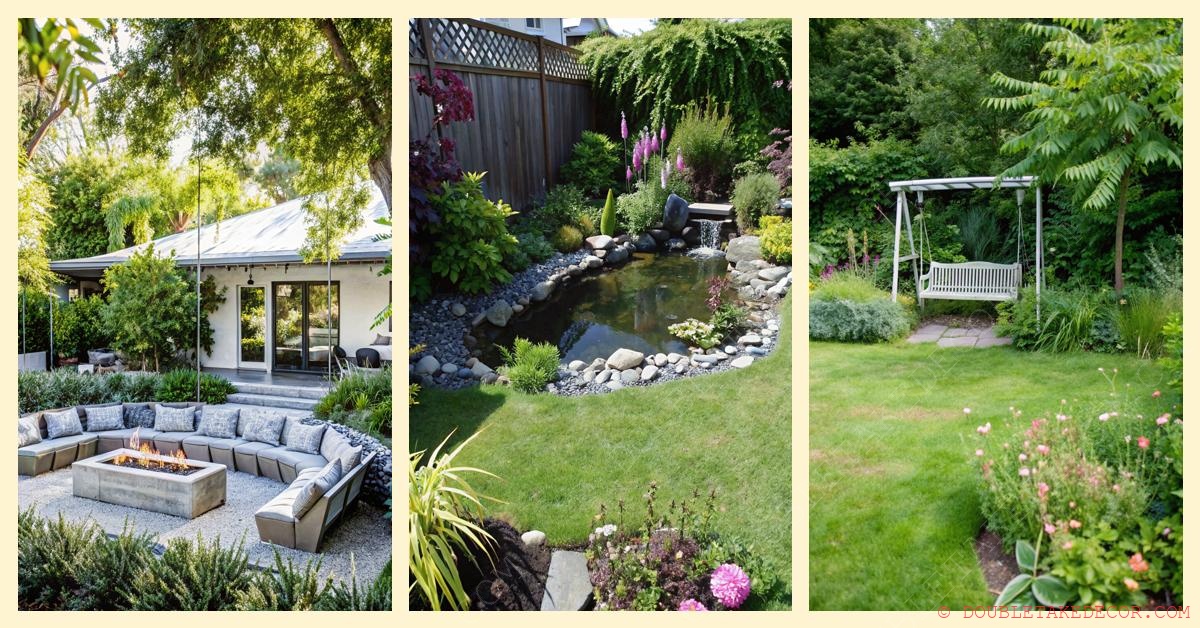
Ultimate Guide to Crafting Your Perfect Backyard Layout

Transform Your Garden with Beautiful Edging Ideas

Transform Your Outdoor Space with Shabby Chic Garden Ideas
